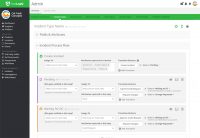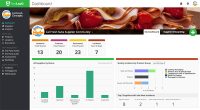The increasing complexity of the global food chain has also increased the complexity of traceability of ingredients. However, FSMA has made this task a critical part of the seed to fork process. More vigilance and awareness of the supply chain is an essential part of protecting consumers and the company brand, and plays in an important role in the event of a recall. In a Q&A with Food Safety Tech Dean Wiltse, CEO of FoodLogiQ, explains the issues the food industry is experience in this area and why transparency in the supply chain will become the new normal.
Food Safety Tech: What are the biggest supply chain challenges you see industry facing today?
Dean Wiltse: The biggest challenge we see in the food supply chain is getting beyond the “one-up and one-back” approach to supply chain management to achieve real transparency in the supply chain. Now I think more than ever consumers want to know more information about their food and 2017 is going to be the year of transparency. A year of getting beyond one-up and one-back, and beyond the four walls of the food manufacturing facility to really dig down and understand what is going on two, three, four, or five levels down the supply chain, from a safety and risk mitigation standpoint.
I also think food companies will continue to be challenged by the ripple effect of increased recalls: Sunflower seeds, flour, powdered milk. Many food companies were rocked with these recalls in 2016. We expect these recalls to continue in scale and frequency going into 2017.
Another challenge is in the area of quality incidents—and the monitoring of those quality incidents. Oftentimes these quality issues go unchecked and it’s damaging to the quality of your food—and of course your brand—as well as damaging to the bottom line.
FST: How should companies monitor and ensure that they are getting high quality product from suppliers?
Wiltse: It sounds simple, but it all starts with being aware of exactly where you are experiencing quality issues across your supply chain. At FoodLogiQ, we pull all of the quality and incident data together in our dashboard to enable food companies to know exactly which suppliers you are having quality issues with and which ones you aren’t.
 |
 |
| FoodLogiQ dashboards enable users to monitor quality issues in the supply chain and document incidents. (Click above images to enlarge the dashboards) | |
Tracking and documenting these incidents—followed by the corrective actions—is critical. It is also important that all of the requirements and expectations are communicated openly; it makes the food supply chain safer by opening up transparency.
Customers can also use our technology to aggregate the quality and safety data into a star rating for their suppliers. Defining what is important to you from a quality and safety standpoint and aggregate that data in the software, and then assign a star rating for your suppliers. You can then use this star rating to formulate your preferred and approved supplier list.
FST: Where are the biggest disconnects in the supply chain? And how can companies rectify this?
Wiltse: Back to what the consumer is demanding: More information about their food, where it came from and what exactly is in it. Leading food brands want to provide this level of transparency to their consumers, but many are struggling with delivering this information in an authentic, real-time fashion.
Today there’s technology that can deliver it to them. In order to get more granular and provide more detailed information through the supply chain, there’s a cost associated with that, even down to the labeling at the grower for traceability. Many in the industry view this as an additional cost, but the leaders see this as a strategic investment and realize there is significant ROI in supply chain transparency.
FST: What are the most serious concerns surrounding FSMA and the supply chain?
Wiltse: Clearly the majority of the industry has been preparing for FSMA for several years now, getting their processes in place, if they weren’t already. Where we see a significant opportunity for companies to be proactive is in centralizing their required records, safety plans, and other essential processes into one platform for their entire supply chain.
We see many food companies who may have the required documentation and corrective actions in place, but they are scattered or siloed throughout the organization, and not centralized and easily accessible when the FDA calls on you to provide that information.
Another challenge is certainly top of mind is foreign supplier verification. The wave of required verification for foreign suppliers will be significant for many companies so they must be vigilant and start that process now or risk a significant disruption to their business.



